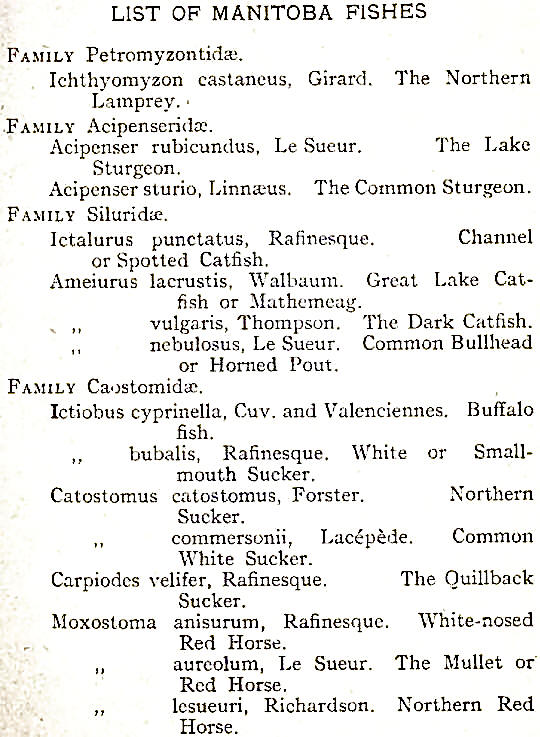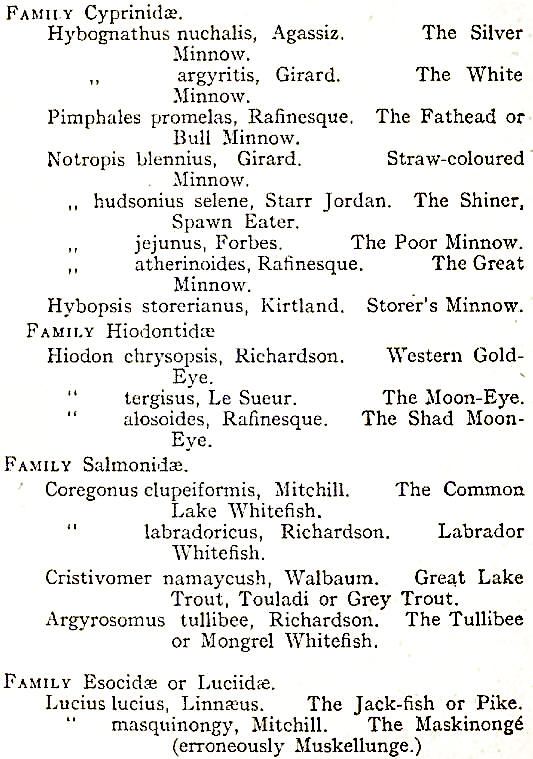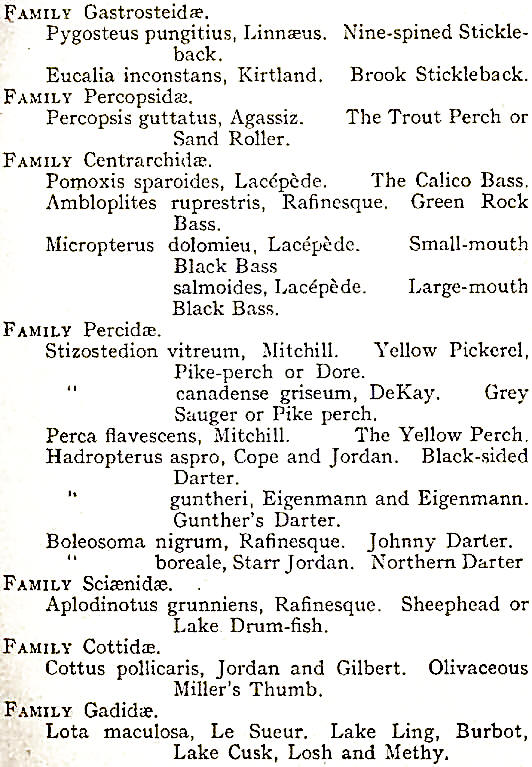|
Dominion Commissioner of Fisheries and Canadian Representative on
the International
Fisheries Commission.
IT
has been justifiably claimed for the fishing industries of Manitoba that
they are the greatest fresh-water fisheries in the world. The earliest
fishery was carried on by the native Indian tribes for food for
themselves and their dogs, but the officers of the Hudson’s Bay Company,
at their numerous posts in this region, de-< pended upon fish very
largely, and since 1811, when the first white settlers were brought to
the banks of the Red River by Lord Selkirk, a regular fishery has been
pursued, which has grown to enormous dimensions, especially during the
last thirty years. The species of principal importance are the lake
whitefish (Coregonus
clupei-formis), the pike-perch or yellow
pickerel (Stitzostedion
vitreum), the sturgeon (Acipenser),
and the pike or jackfish
{Lucius).
The whitefish of Manitoba, especially of Lake Winnipeg, have an envied
reputation in the markets of this continent; and the caviare and flesh
of the sturgeon from these waters have always ranked very high. The
relative economic importance of the following species may be judged from
the figures given below.

During the last twenty years the annual value of the fisheries of the
Province has risen rapidly, partly owing to the exploitation of new
waters, and partly owing to the higher market value of food-fishes in
recent years. Thus, in 1887, the total value was $129,084, in 1897
$261,120, and in 1907 it was $800,015. While a proportion of the catch
is sent to local and to Eastern Canadian markets, the greater part
(fully 75%) is sent to the United States markets, certain large foreign
“fish combines” having undoubted control over the handling of these
supplies of Canadian fish. The last official returns (1907) credit the
Province with a total catch of 10,538,500 lbs. of fish of all kinds for
that year.
The
total area of the waters fished is not less than 20,000 square miles,
the three largest lakes, Lake Winnipeg (9,460 sq. miles), Lake
Winnipegosis (2,068 sq. miles), and Lake Manitoba (1,775 sq. miles)
exceeding the Netherlands in extent, but other lakes, St. Martin,
Dauphin, Shoal, Swan and Waterhen, contribute their quota, these lakes
ranging from 100 to 200 square miles, while Moose (552 sq. miles), Cedar
(285 sq. miles), Play-green (223 sq. miles) and other more distant
lakes, though beyond the Provincial boundary, must be included in the
Manitoba fisheries, all the catches being sent down to the main shipping
points in the Province. It is interesting to note that the Manitoba
lakes are exclusively in Canadian territory, and are not shared, as are
the Great Lakes to the east, with the Republic to the south. Hence,
while Lake Superior is more than three times the area of Lake Winnipeg,
Huron twice, and Erie almost of the same area, yet the superficial
extent of the Canadian portion of these eastern waters does not greatly
exceed the total area of the Manitoba fishing grounds.
To
develop the fishing industry on an adequate scale, in waters so vast,
large capital was essential Fishing companies were accordingly
organized, with fleets of steam tugs, immense outfits of nets, ice
houses and stores, refrigerators and other necessary equipment. Fishing
on a limited scale had always been engaged in by the settlers and
Indians, and the numerous Icelandic colonies in more recent years have
assiduously continued this practice. Much of this fishing is carried on
through holes in the ice in winter. But even so recently as 1899 the
Winnipeg Board of Trade stated that the fishing industries of the
Province were only “in their infancy," and undoubtedly, with proper
safeguards against depletion, these industries, which have increased,
like the population of the Province, more than sixfold during the last
twenty years, are still capable of further development. The
productiveness of the waters of the Province is proved by the fact that
from 1890 to 1907 84,000,000 lbs. of whitefish were shipped from
Manitoba and 5,329,000 lbs. of sturgeon, including a large quantity of
caviare, much of it exported to German)'' to be sold as the best Russian
product. Like all fisheries, those of this Province have been subject to
fluctuations ; some branches, such as the sturgeon fishery, have
alarmingly declined, while others, like the pike-perch or pickerel
fishery, have greatly expanded. The whitefish supply, in the opinion of
many, has decreased, and the large annual catch, in 1906 exceeding
5,000,000 lbs., was, it is held, due only to more persistent fishing and
the use of excessive amounts of gear. All fishing operations are carried
on under license from the Dominion Government, and under the supervision
of a staff of Federal fishery officers, who have authority to enforce
the laws and regulations under the Dominion Fishery Act.
The
parties who carry on fishing consist of (1) large fishing companies in
which United States firms have very considerable interest, they operate
in the northern parts of Lake Winnipeg and the more distant lakes,
chiefly in summer and in extensive areas where fishermen without
capital, tugs, fish-houses and refrigerators could not take or handle
the fish. (2) Settlers, largely Scandinavians, with a proportion of
Austrians and Germans, who fish in summer in small boats, and, on a
vastly more extensive scale, through the ice in winter, mainly in the
shallower southern parts of Lake Winnipeg and in the smaller lakes. (3)
Indians and half-breeds, who fish from their reserves for food but also
for sale, and have specially carried on .a sturgeon fishery. In the
rivers, such as the Red River, settlers and others use seines and other
apparatus for catching pickerel or pike perch, catfish, gold-eyes (an
excellent fresh-water herring), perch, and coarse fish.
It
is estimated that at least 5,000 persons are more or less engaged in the
fisheries, but the number of regular fishermen is now about 2,000, as
compared with 850 twenty years ago. In 1887, it may be noted, there were
7 steam tugs, 550 tons total, valued at $26,500; and 65 fishing boats,
118 tons, valued at $6,785; whereas there are now 22 tugs of 1,034 tons
total tonnage, valued at $132,000 and employing about 150 men, and in
addition 530 boats, valued at $24,000, with crews totalling up to 1,800
men. Fishing by means of baited lines, fyke or hoop nets, etc., is
extensively pursued, and the takes are principally coarse fish, the
present annual catch of which amounts to no less than 5,000,000 lbs. The
cleaning of the fish, icing, and other processes are carried out at
various points on the lakes, such as Spider Island, Black River, Eagle
Island, Poplar River, Beren's River, Snake Island, Bull Head, Horse
Island, and Warren’s Landing, these resembling busy villages, with
wharves and crowded dwellings. Warren’s Landing is about 400 miles from
Winnipeg city. About ten years ago fresh fish, in broken ice, were first
brought from Selkirk Island (at the north en<J of Lake Winnipeg) and
shipped from the town of Selkirk in refrigerator cars, and were found in
some United States cities to be preferred to the frozen fish heretofore
imported. A large business has been since then maintained. The main
catches brought from the fishing grounds by tugs and sail-boats to the
various islands referred to, after being cleaned, packed, and iced, are
brought down to Selkirk from Lake Winnipeg, and to Winnipegosis Town,
from Winnipegosis, Cedar, and other lakes. From over a hundred of these
remote establishments, with plants valued at nearly $250,000, the
principal summer catches are received at the large refrigerators. That
of the Dominion Fish Company at Selkirk is said to be the largest in
Canada, if not on the whole American continent, having a capacity of two
million pounds, though many times that amount passes through the
freezing rooms in a single season. In the large freezers the fish are
neatly laid on flat trays, subjected to a temperature of 15° below zero,
and exported by the carload when the markets are favourable. The ammonia
process has been adopted, the ammonia being forced by powerful engines
into vacua, thus reducing the temperature, and the cold gas is then
driven through circulating pipes, which pass along the insulated store
rooms, where a temperature of 20° below freezing can be readily
attained, but the usual temperature is only about zero. The ammonia,
after circulating, is restored to its original density by the action of
running water and is ready for the circulating process again. In the
large refrigerator establishment just mentioned about 3,000 lbs. of
ammonia are used, emptying and re-filling being carried out several
times in the course of the year.
Unlike the fisheries of Ontario and the eastern Provinces and British
Columbia, in which each Province has property rights, the property and
jurisdiction are, in Manitoba, vested solely in the hands of the
Dominion
Government; and the Minister of Marine and Fisheries, Ottawa, issues
licenses, authorizes restrictions, close seasons, etc., for the
preservation of the fishery resources. As an effective safeguard against
depletion the Federal Government has erected fish-hatcheries (at
Selkirk, Beren’s River, Winnipegosis, and other places), and vast
quantities of fry of whitefish, and various valuable species, are
planted each season from these establishments.
NOTES ON THE FISHES OF
MANITOBA
Apart from their commercial importance, the fishes of the Province have
a scientific interest arising from the fact that they form a fish fauna
distinctly marked off from that of the great lakes and eastern waters,
and have nothing in common with the Pacific fish fauna. None of the
ancient fresh-water types of Canada such as the Gar-p;ke (.Lepisosteus
osseus,
Linn) and Bowfin
(Amia
calva,
Linn) occur, though sturgeon of two species are
found, but the sturgeon is doubtless, primitively, an anadromous ocean
fish. The speckled char or brook trout (Salvelinus
fontinalis,
Mitch.), the lesser whitefish
(Argyrosomus
artedi,
Le Sueur), the sea salmon
(Salmo
salar,
Linn.), as also the black spotted trout (S.
clarkii)
of Albertan waters, the Inconnu (Stenodus
mackenzii, Richardson) of the Mackenzie, and
certain Arctic and Pacific salmon and trout are absent, and bear out the
geologist’s view that the Manitoba system of lakes and rivers is
unconnected with the eastern and western drainage systems, and really
comprises the remnants of a northern expansion of the Missouri and
Mississippi system with a former outflow to the south. Geographi oally
these lakes are the western members of the great lake chain lying, for a
thousand miles, along the southern margin of the vast Archaean shield
which dips, to the north, beneath the waters of Hudson Bay. Geologi
cally they are all that remain of the vast post-glacial Lake Agassiz, of
an estimated area of 110,000 sq. miles, the sediments of which, as the
late Dr. George Dawson said, “constitute the richest wheat lands of
Manitoba.” Near the Cypress Hills on the west and in the opposite
direction (south of Lake of the Woods) the Manitoba waters still
maintain communication by muskegs and marshy streams with the
Mississippi system to the south.
The
presence in abundance of a lesser whitefish, not found to the east or
the west, viz., the Tullibee (Argyro-somus
tullibee,
Richardson), a soft inferior lesser white-fish or
lake herring, and of the Gold-eye (Hiodon
chrysop-sis,
Richardson), an ally of the Clupeidas, a very
plentiful and excellent food-fish, emphasises the separateness of this
aquatic area, while the presence of the sturgeon and of the Methy or
Lake Ling (Lota
maculosa,
Le Sueur) indicates that connections with the sea,
such, as geology demonstrates, have occurred, owing to subsidence at
various epochs. Certain universally distributed species are found, e.g.,
the pikes or jack-fishes (of which two species occur,
Lucius lucius
Linn., and
Lucius masquinongy,
Mitchill), both of exceptionally good table
qualities, as well as the bearded cat-fishes and carp-like suckers; but
the glutinous nature of their eggs may explain their wide dispersion,
probably by water birds.
The
following list of species is believed to include most of the fishes
authentically known to occur, but many other species await discovery in
this extensive area, of waters where investigations, so far, have been
fragmentary and inadequate.



|
